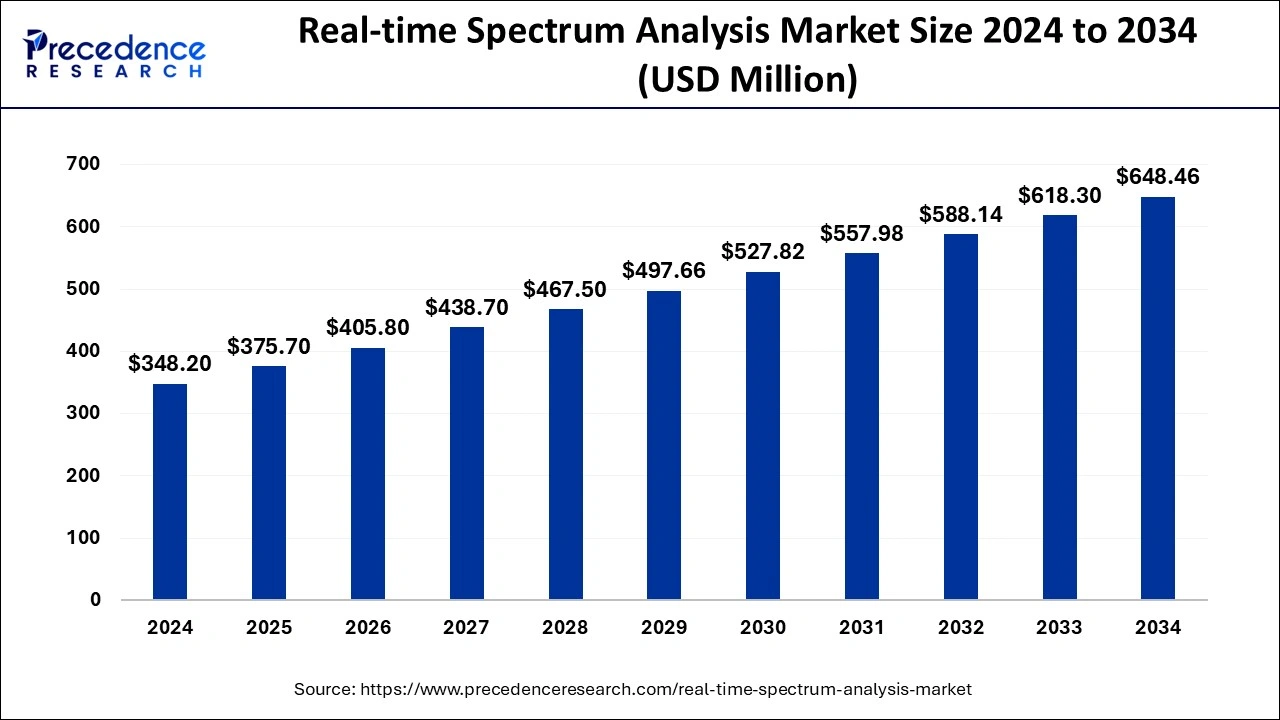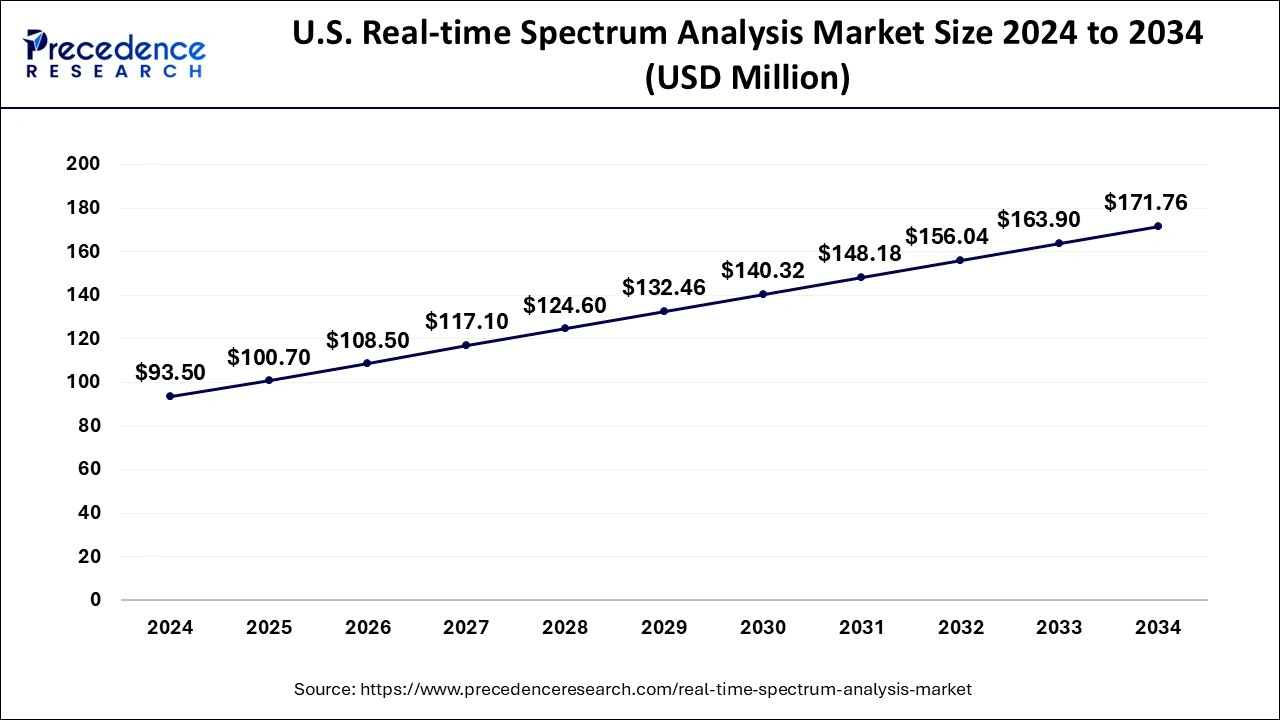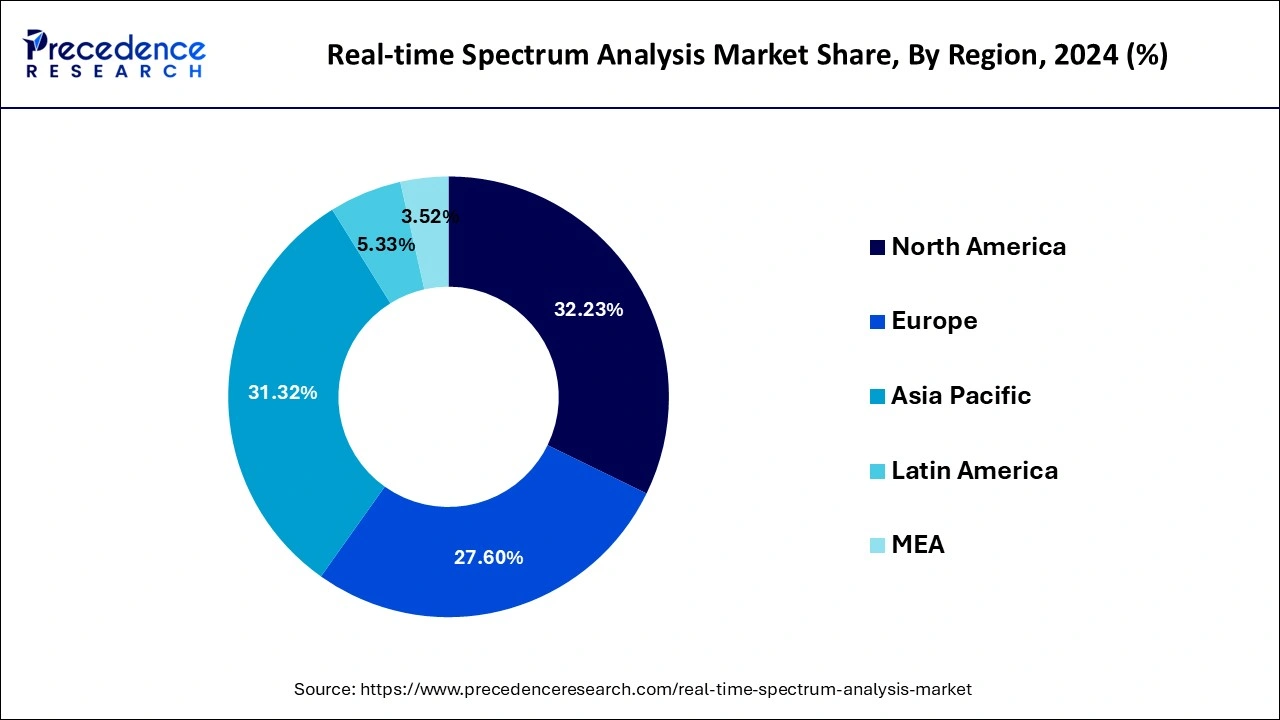March 2024
The global real-time spectrum analysis market size was accounted for USD 348.20 million in 2024, grew to USD 375.70 million in 2025 and is predicted to surpass around USD 648.46 million by 2034, representing a healthy CAGR of 6.41% between 2025 and 2034. The North America real-time spectrum analysis market size was calculated at USD 112.21 million in 2024 and is expected to grow at a fastest CAGR of 6.43% during the forecast year.
The global real-time spectrum analysis market size was estimated at USD 348.20 million in 2024 and is anticipated to reach around USD 648.46 million by 2034, expanding at a CAGR of 6.41% from 2025 to 2034.

The U.S. real-time spectrum analysis market size was evaluated at USD 93.50 million in 2024 and is predicted to be worth around USD 171.76 million by 2034, rising at a CAGR of 6.46% from 2025 to 2034.

North America dominated the global real-time spectrum analysis market with the largest market share of 32.23% in 2024. Presence of major manufacturers in the U.S. and quick uptake of latest technologies are the key factors contributing the growth of real-time spectrum analysis market in North America.

Asia Pacific is expected to expand at a solid CAGR during the forecast period. The Asia Pacific region is expected to major revenue chunk of the global real-time spectrum analysis market. The expected launch of 5G services in major countries like China, Japan, Korea, and India is expected to boost the demand for spectrum management in the Asia Pacific region. The European region accounted for a revenue share of 28% in 2019 of the global market. High investment in the research and development and presence of latest communication infrastructure will generate high demand for real-time spectrum analysis.
The propagation of wireless applications and amenities has increased the mandate for radio frequency (RF) range. As increasing number of radio transmitters are affixed into the RF system, the possibility for RF interference grows significantly. RF interference (RFI) can be described as the effect of unsolicited energy due to single or a combination of radiations, emissions, inductions or conductions upon entrance in a radio communication arrangement, manifested by any presentation degradation, misconception, or loss of info which could be derived in the absence of such undesirable energy.
One of the major applications of real-time spectrum analysis is the spectrum monitoring of Wi-Fi and Bluetooth. As Wi-Fi and Bluetooth progress and become even further prominent, different test apparatuses are required to ensure systems match the key performance indicators (KPIs). Conventionally, field engineers and technicians used the swept frequency spectrum analyzers to supervise activity in the 2.4 GHz ISM band. The swept-tuned apparatuses, however, are not able to provide a comprehensive sight because most indicators in the group are short in length and/or frequency hop at fast rates. Supervise up to three Wi-Fi admittance points and their linked devices along with the Bluetooth devices and supplementary potential handlers becomes highly impossible with a swept frequency spectrum analyzer. Thus, the usage of real-time spectrum analyzers is on the upsurge. Thus, the widespread adoption of Bluetooth and Wi-Fi in everything from headsets, PCs and cell phones to debit and credit card readers will drive the market for real-time spectrum analysis.
Today's RF/Microwave ecosphere is merging the digital computing and conventional analog RF machineries. This amalgamation of analog and digital RF is offering engineers a new highly intricate environment, demanding a new generation of RF/Microwave examination tools. The application of real-time spectrum analysis in pulse measurement, radar, and RFID is expected to create new opportunities for the market players. Further, the advantages of real-time spectrum analyzer over other tools in relation with measurement of frequency will boost the demand for global real-time spectrum analysis market.
| Report Highlights | Details |
| Market Size in 2024 | USD 348.20 Million |
| Market Size in 2025 | USD 375.70 Million |
| Market Size by 2034 | USD 648.46 Million |
| Growth Rate from 2025 to 2034 | CAGR of 6.41% |
| Largest Market | North America |
| Base Year | 2024 |
| Forecast Period | 2025 to 2034 |
| Segments Covered | Product Type, Application Type, Region Type |
The global real-time spectrum analysis market has been segmented into product type and application. The product type segment has been further divided into handheld analyzer, benchtop analyzer, and portable analyzer. Based on application, the real-time spectrum analysis market has been divided into healthcare, automotive, energy & power, aerospace & defense, IT& telecommunication, semiconductor & electronics, industrial, and others.
The benchtop analyzers dominated the product type segment mainly due to applications in commercial settings and wide options of products. Portable analyzers are the second-most revenue generating product type. Ease of use and low cost are the major factors responsible for the high growth of portable analyzers.
IT & telecommunication domain generated highest revenue within the application segment. The prime reason is the increased demand for spectrum management. Applications in automotive sector are expected to exhibit high compounded annual growth rate (CAGR) in the forecast time-frame. The global market for the IT & telecommunication is expected to grow at a significant CAGR from 2025 to 2034.
By Product
By Application
By Region
For inquiries regarding discounts, bulk purchases, or customization requests, please contact us at sales@precedenceresearch.com
No cookie-cutter, only authentic analysis – take the 1st step to become a Precedence Research client
March 2024
January 2024
July 2024
October 2024